中国饮食文化中英文说课讲解
- 格式:ppt
- 大小:4.17 MB
- 文档页数:31
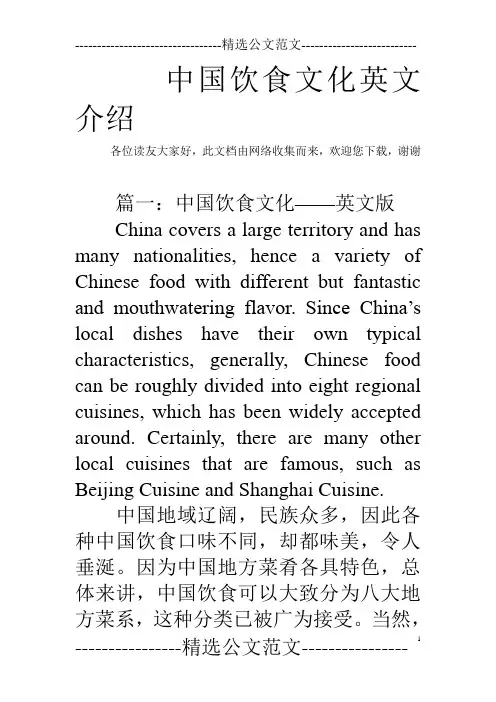
中国饮食文化英文介绍各位读友大家好,此文档由网络收集而来,欢迎您下载,谢谢篇一:中国饮食文化——英文版China covers a large territory and has many nationalities, hence a variety of Chinese food with different but fantastic and mouthwatering flavor. Since China’s local dishes have their own typical characteristics, generally, Chinese food can be roughly divided into eight regional cuisines, which has been widely accepted around. Certainly, there are many other local cuisines that are famous, such as Beijing Cuisine and Shanghai Cuisine.中国地域辽阔,民族众多,因此各种中国饮食口味不同,却都味美,令人垂涎。
因为中国地方菜肴各具特色,总体来讲,中国饮食可以大致分为八大地方菜系,这种分类已被广为接受。
当然,还有其他很多著名的地方菜系,例如北京菜和上海菜。
Shandong Cuisine山东菜系Consisting of Jinan cuisine and Jiaodong cuisine, Shandong cuisine, clear, pure and not greasy, is characterized by its emphasis on aroma, freshness, crispness and tenderness. Shallot and garlic are usually used as seasonings so Shangdong dishes tastes pungent usually. Soups are given much emphasis in Shangdong dishes. Thin soup features clear and fresh while creamy soup looks thick and tastes strong. Jinan cuisine is adept at deep-frying, grilling, frying and stir-frying while Jiaodong division is famous for cooking seafood with fresh and light taste.山东菜系,由济南菜系和胶东菜系组成,清淡,不油腻,以其香,鲜,酥,软而闻名。

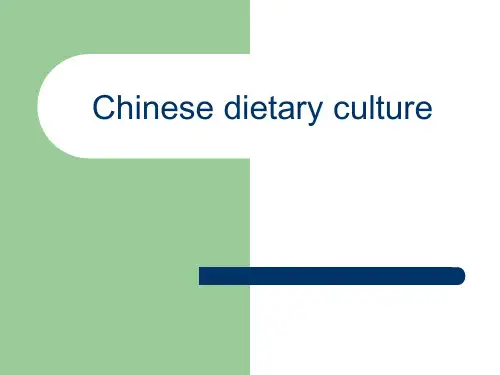
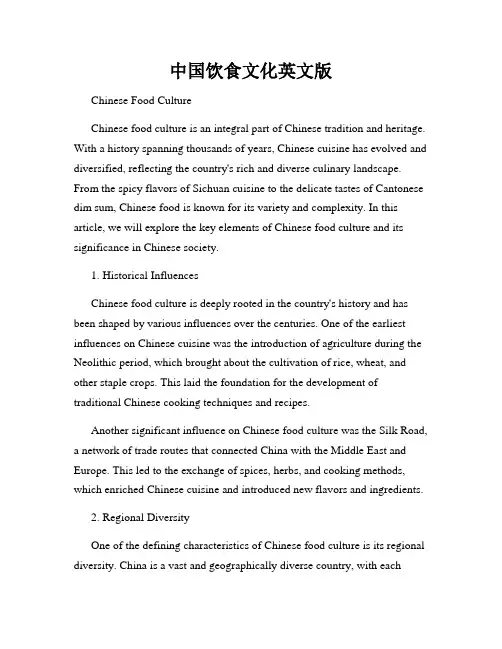
中国饮食文化英文版Chinese Food CultureChinese food culture is an integral part of Chinese tradition and heritage. With a history spanning thousands of years, Chinese cuisine has evolved and diversified, reflecting the country's rich and diverse culinary landscape. From the spicy flavors of Sichuan cuisine to the delicate tastes of Cantonese dim sum, Chinese food is known for its variety and complexity. In this article, we will explore the key elements of Chinese food culture and its significance in Chinese society.1. Historical InfluencesChinese food culture is deeply rooted in the country's history and has been shaped by various influences over the centuries. One of the earliest influences on Chinese cuisine was the introduction of agriculture during the Neolithic period, which brought about the cultivation of rice, wheat, and other staple crops. This laid the foundation for the development of traditional Chinese cooking techniques and recipes.Another significant influence on Chinese food culture was the Silk Road, a network of trade routes that connected China with the Middle East and Europe. This led to the exchange of spices, herbs, and cooking methods, which enriched Chinese cuisine and introduced new flavors and ingredients.2. Regional DiversityOne of the defining characteristics of Chinese food culture is its regional diversity. China is a vast and geographically diverse country, with eachregion having its own unique culinary traditions and specialties. For example, the spicy and numbing flavors of Sichuan cuisine are a stark contrast to the light and fresh flavors of Shandong cuisine.Each region in China has its own distinct ingredients, cooking styles, and flavor profiles, which are influenced by local customs, climate, and geography. This regional diversity has contributed to the richness and depth of Chinese cuisine, making it one of the most diverse and vibrant culinary traditions in the world.3. Social SignificanceIn Chinese culture, food is not just sustenance but also a symbol of social connections and harmony. Shared meals play a central role in Chinese social life, bringing families and communities together to celebrate festivals, weddings, and other important occasions. The act of preparing and sharing food is seen as a way to strengthen bonds and foster relationships.Food also holds symbolic significance in Chinese culture, with certain dishes and ingredients representing prosperity, happiness, and good fortune. For example, fish is often served whole during Lunar New Year celebrations to symbolize abundance and prosperity, while dumplings are eaten to usher in wealth and good luck.4. Traditional PracticesChinese food culture is steeped in tradition, with many customs and practices that have been passed down through generations. One such practice is the concept of "balance" in Chinese cuisine, which emphasizes the harmony of flavors, textures, and colors in a meal. It is believed that a well-balanced meal not only nourishes the body but also balances the body's energy and promotes good health.Another traditional practice in Chinese food culture is the use of food as medicine. Many ingredients in Chinese cuisine, such as ginseng, goji berries, and lotus seeds, are believed to have healing properties and are used in traditional Chinese medicine to treat various ailments.5. Modern TrendsWhile Chinese food culture is steeped in tradition, it has also evolved and adapted to changing tastes and lifestyles. In recent years, there has been a growing interest in healthy eating and sustainable food practices in China, leading to the popularity of organic and locally sourced ingredients.The rise of food delivery services and online platforms has also transformed the way Chinese people eat, making it easier to access a wide range of cuisines from the comfort of their homes. Despite these changes, traditional Chinese food culture continues to thrive, with a renewed interest in preserving and promoting the country's culinary heritage.In conclusion, Chinese food culture is a reflection of the country's rich history, regional diversity, and social values. With its emphasis on balance, harmony, and tradition, Chinese cuisine remains one of the most vibrant and enduring culinary traditions in the world. By exploring the key elements of Chinese food culture, we can gain a deeper appreciation for the role that food plays in Chinese society and its significance in everyday life.。
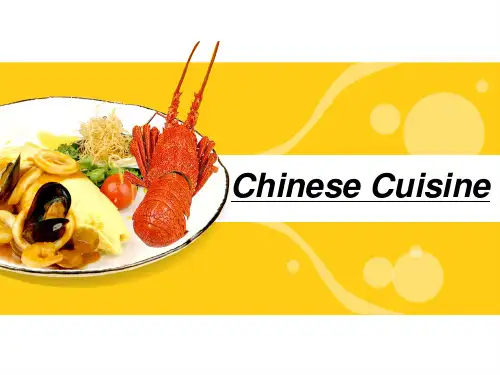
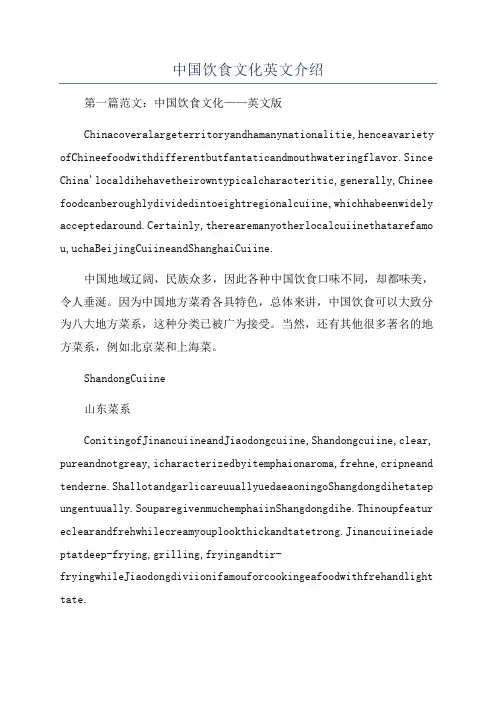
中国饮食文化英文介绍第一篇范文:中国饮食文化——英文版Chinacoveralargeterritoryandhamanynationalitie,henceavariety ofChineefoodwithdifferentbutfantaticandmouthwateringflavor.Since China'localdihehavetheirowntypicalcharacteritic,generally,Chinee foodcanberoughlydividedintoeightregionalcuiine,whichhabeenwidely acceptedaround.Certainly,therearemanyotherlocalcuiinethatarefamo u,uchaBeijingCuiineandShanghaiCuiine.中国地域辽阔,民族众多,因此各种中国饮食口味不同,却都味美,令人垂涎。
因为中国地方菜肴各具特色,总体来讲,中国饮食可以大致分为八大地方菜系,这种分类已被广为接受。
当然,还有其他很多著名的地方菜系,例如北京菜和上海菜。
ShandongCuiine山东菜系ConitingofJinancuiineandJiaodongcuiine,Shandongcuiine,clear, pureandnotgreay,icharacterizedbyitemphaionaroma,frehne,cripneand tenderne.ShallotandgarlicareuuallyuedaeaoningoShangdongdihetatep ungentuually.SouparegivenmuchemphaiinShangdongdihe.Thinoupfeatur eclearandfrehwhilecreamyouplookthickandtatetrong.Jinancuiineiade ptatdeep-frying,grilling,fryingandtir-fryingwhileJiaodongdiviionifamouforcookingeafoodwithfrehandlight tate.山东菜系,由济南菜系和胶东菜系组成,清淡,不油腻,以其香,鲜,酥,软而闻名。
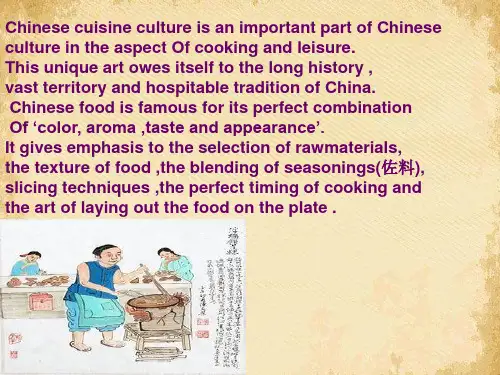
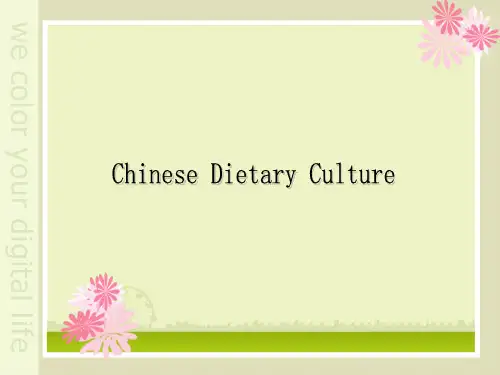
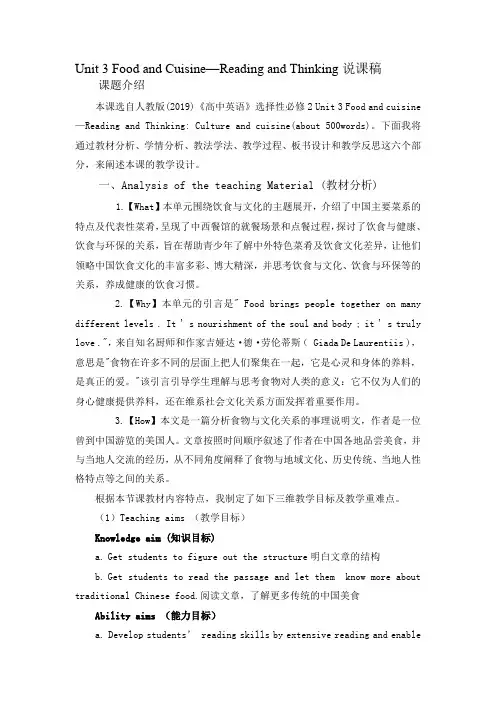
Unit 3 Food and Cuisine—Reading and Thinking说课稿课题介绍本课选自人教版(2019)《高中英语》选择性必修2 Unit 3 Food and cuisine —Reading and Thinking: Culture and cuisine(about 500words)。
下面我将通过教材分析、学情分析、教法学法、教学过程、板书设计和教学反思这六个部分,来阐述本课的教学设计。
一、Analysis of the teaching Material (教材分析)1.【What】本单元围绕饮食与文化的主题展开,介绍了中国主要菜系的特点及代表性菜肴,呈现了中西餐馆的就餐场景和点餐过程,探讨了饮食与健康、饮食与环保的关系,旨在帮助青少年了解中外特色菜肴及饮食文化差异,让他们领略中国饮食文化的丰富多彩、博大精深,并思考饮食与文化、饮食与环保等的关系,养成健康的饮食习惯。
2.【Why】本单元的引言是" Food brings people together on many different levels . It ' s nourishment of the soul and body ; it ' s truly love .",来自知名厨师和作家吉娅达·德·劳伦蒂斯( Giada De Laurentiis ),意思是"食物在许多不同的层面上把人们聚集在一起,它是心灵和身体的养料,是真正的爱。
"该引言引导学生理解与思考食物对人类的意义:它不仅为人们的身心健康提供养料,还在维系社会文化关系方面发挥着重要作用。
3.【How】本文是一篇分析食物与文化关系的事理说明文,作者是一位曾到中国游览的美国人。
文章按照时间顺序叙述了作者在中国各地品尝美食,并与当地人交流的经历,从不同角度阐释了食物与地域文化、历史传统、当地人性格特点等之间的关系。
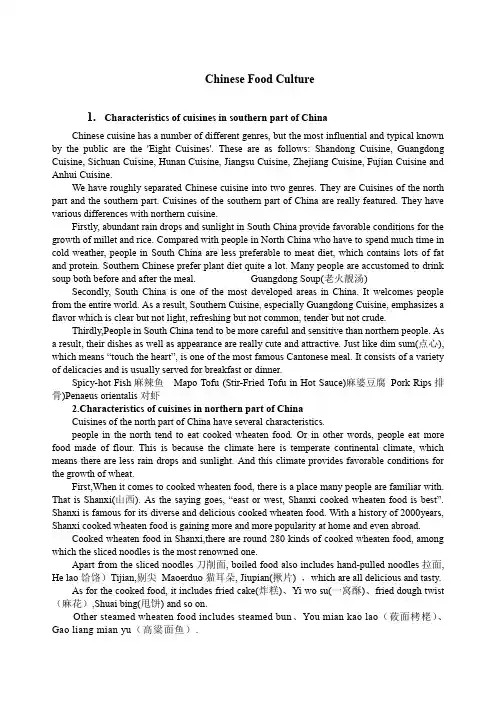
Chinese Food Culture1.Characteristics of cuisines in southern part of ChinaChinese cuisine has a number of different genres, but the most influential and typical known by the public are the 'Eight Cuisines'. These are as follows: Shandong Cuisine, Guangdong Cuisine, Sichuan Cuisine, Hunan Cuisine, Jiangsu Cuisine, Zhejiang Cuisine, Fujian Cuisine and Anhui Cuisine.We have roughly separated Chinese cuisine into two genres. They are Cuisines of the north part and the southern part. Cuisines of the southern part of China are really featured. They have various differences with northern cuisine.Firstly, abundant rain drops and sunlight in South China provide favorable conditions for the growth of millet and rice. Compared with people in North China who have to spend much time in cold weather, people in South China are less preferable to meat diet, which contains lots of fat and protein. Southern Chinese prefer plant diet quite a lot. Many people are accustomed to drink soup both before and after the meal. Guangdong Soup(老火靓汤) Secondly, South China is one of the most developed areas in China. It welcomes people from the entire world. As a result, Southern Cuisine, especially Guangdong Cuisine, emphasizes a flavor which is clear but not light, refreshing but not common, tender but not crude.Thirdly,People in South China tend to be more careful and sensitive than northern people. As a result, their dishes as well as appearance are really cute and attractive. Just like dim sum(点心), which means “touch the heart”, is one of the most famous Cantonese meal. It consists of a variety of delicacies and is usually served for breakfast or dinner.Spicy-hot Fish麻辣鱼Mapo Tofu (Stir-Fried Tofu in Hot Sauce)麻婆豆腐Pork Rips排骨)Penaeus orientalis对虾2.Characteristics of cuisines in northern part of ChinaCuisines of the north part of China have several characteristics.people in the north tend to eat cooked wheaten food. Or in other words, people eat more food made of flour. This is because the climate here is temperate continental climate, which means there are less rain drops and sunlight. And this climate provides favorable conditions for the growth of wheat.First,When it comes to cooked wheaten food, there is a place many people are familiar with. That is Shanxi(山西). As the saying goes, “east or west, Shanxi cooked wheaten food is best”. Shanxi is famous for its diverse and delicious cooked wheaten food. With a history of 2000years, Shanxi cooked wheaten food is gaining more and more popularity at home and even abroad.Cooked wheaten food in Shanxi,there are round 280 kinds of cooked wheaten food, among which the sliced noodles is the most renowned one.Apart from the sliced noodles刀削面, boiled food also includes hand-pulled noodles拉面, He lao饸饹)Tijian,剔尖Maoerduo猫耳朵, Jiupian(揪片) ,which are all delicious and tasty.As for the cooked food, it includes fried cake(炸糕)、Yi wo su(一窝酥)、fried dough twist (麻花),Shuai bing(甩饼) and so on.Other steamed wheaten food includes steamed bun、You mian kao lao(莜面栲栳)、Gao liang mian yu(高粱面鱼).Second, food in the north is often more salty and greasy than that in the south. Because people like to add more ingredient to dishes even the soup.Shandong cuisine and Beijing cuisines are two famous cuisines of the eight cuisines in china. And they are also representatives of the northern cuisines. Beijing cuisine is famous for its Beijing roast duck and instant-boiled mutton. Shandong food is always pure, fresh, tender, salty and crisp.Chinese people pay much attention to eating, not just to fulfill our basic needs, but deep within, it contains the measures Chinese people take to understand things. For example, when a child was born, relatives and friends would eat eggs painted in red color to celebrate. Eggs symbolize new lives, eating red eggs embodies the high expectations of the Chinese to carry on the family line. We have feasts in the weddings; we celebrate our birthdays with gatherings and delicious food; we gather with our friends or families to eat, which is a good way to enhance our intimacy.。

中国饮食文化介绍英文版Chinese food culture has a long and rich history dating back thousands of years. It is an integral part of Chinese tradition and plays a significant role in the daily lives of the Chinese people. From the diverse range of ingredients and cooking techniques to the intricate presentation and social significance of meals, Chinese culinary traditions embody the country's vibrant cultural heritage.At the heart of Chinese food culture lies the belief in the harmony between humans and nature. This philosophy is reflected in the emphasis on using fresh, seasonal ingredients and the careful balance of flavors, colors, and textures in each dish. The Chinese culinary approach is often described as a "yin-yang" balance, where contrasting elements such as hot and cold, sweet and sour, or spicy and mild are seamlessly combined to create a dynamic and satisfying dining experience.One of the defining features of Chinese cuisine is its regional diversity. China is a vast and geographically diverse country, and each region has developed its own unique culinary traditionsinfluenced by local climate, geography, and cultural influences. For example, the Cantonese cuisine of the southern Guangdong province is known for its delicate, lightly cooked dishes that highlight the natural flavors of the ingredients. In contrast, the Sichuan cuisine of the southwestern Sichuan province is renowned for its bold, spicy flavors and the use of Sichuan peppercorns, which create a distinctive numbing sensation.Another key aspect of Chinese food culture is the social significance of meals. Sharing food is an integral part of Chinese social rituals and family gatherings. Meals are often served family-style, with multiple dishes placed on the table for everyone to share. This encourages conversation, social interaction, and the appreciation of the diverse flavors and textures of the meal. The act of sharing food is seen as a way to foster relationships, express affection, and create a sense of community.In addition to the social aspect, Chinese cuisine also places great importance on the presentation and aesthetics of the food. The careful arrangement of dishes, the use of colorful garnishes, and the incorporation of symbolic elements, such as the use of auspicious ingredients or the arrangement of dishes to resemble lucky numbers, all contribute to the overall dining experience. The Chinese believe that the appearance of the food should be as pleasing to the eye as the flavors are to the palate.One of the most iconic and well-known aspects of Chinese food culture is the use of chopsticks. Chopsticks have been used in China for thousands of years and are an integral part of the dining experience. They are not only a practical tool for eating but also a symbol of Chinese cultural identity. The art of using chopsticks is deeply ingrained in Chinese culture, and mastering the skill is seen as a sign of cultural refinement and social etiquette.The diversity of Chinese cuisine is also reflected in the wide range of cooking techniques and methods. From the delicate steaming of dim sum to the high-heat wok-frying of stir-fries, Chinese chefs have developed a vast repertoire of cooking techniques that showcase the versatility of their ingredients and the creativity of their culinary traditions. These techniques are often passed down from generation to generation, with each chef putting their own unique spin on traditional recipes.Furthermore, the role of tea in Chinese food culture cannot be overstated. Tea has been an integral part of Chinese society for centuries and is often served alongside meals as a palate cleanser and digestive aid. The ritual of preparing and serving tea is deeply rooted in Chinese cultural practices, with different types of tea being paired with specific dishes to enhance the dining experience.In recent years, Chinese cuisine has gained global recognition and popularity, with Chinese restaurants and dishes becoming increasingly prevalent around the world. However, the essence of Chinese food culture goes beyond just the food itself. It is a rich tapestry of traditions, beliefs, and social customs that are deeply ingrained in the Chinese way of life. As more people discover the wonders of Chinese cuisine, it is essential to appreciate and understand the cultural context and significance that underlie these culinary traditions.In conclusion, the Chinese food culture is a testament to the country's rich history, diverse regional influences, and profound respect for the natural world. From the intricate balance of flavors to the social significance of meals, Chinese cuisine is a celebration of the country's cultural heritage and a window into the heart and soul of the Chinese people. As the world continues to embrace the wonders of Chinese food, it is crucial to recognize and preserve the unique cultural traditions that make it such a beloved and enduring part of the global culinary landscape.。